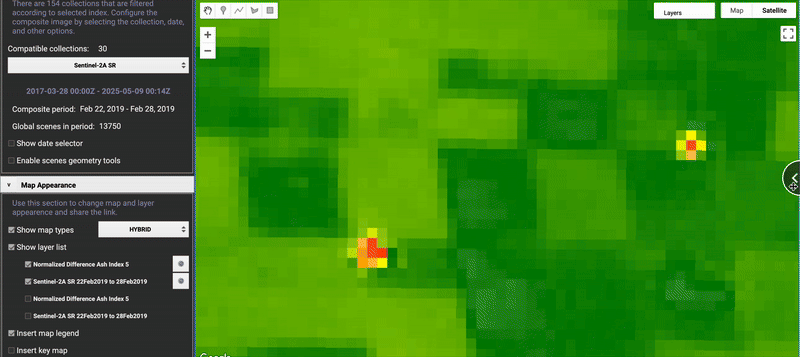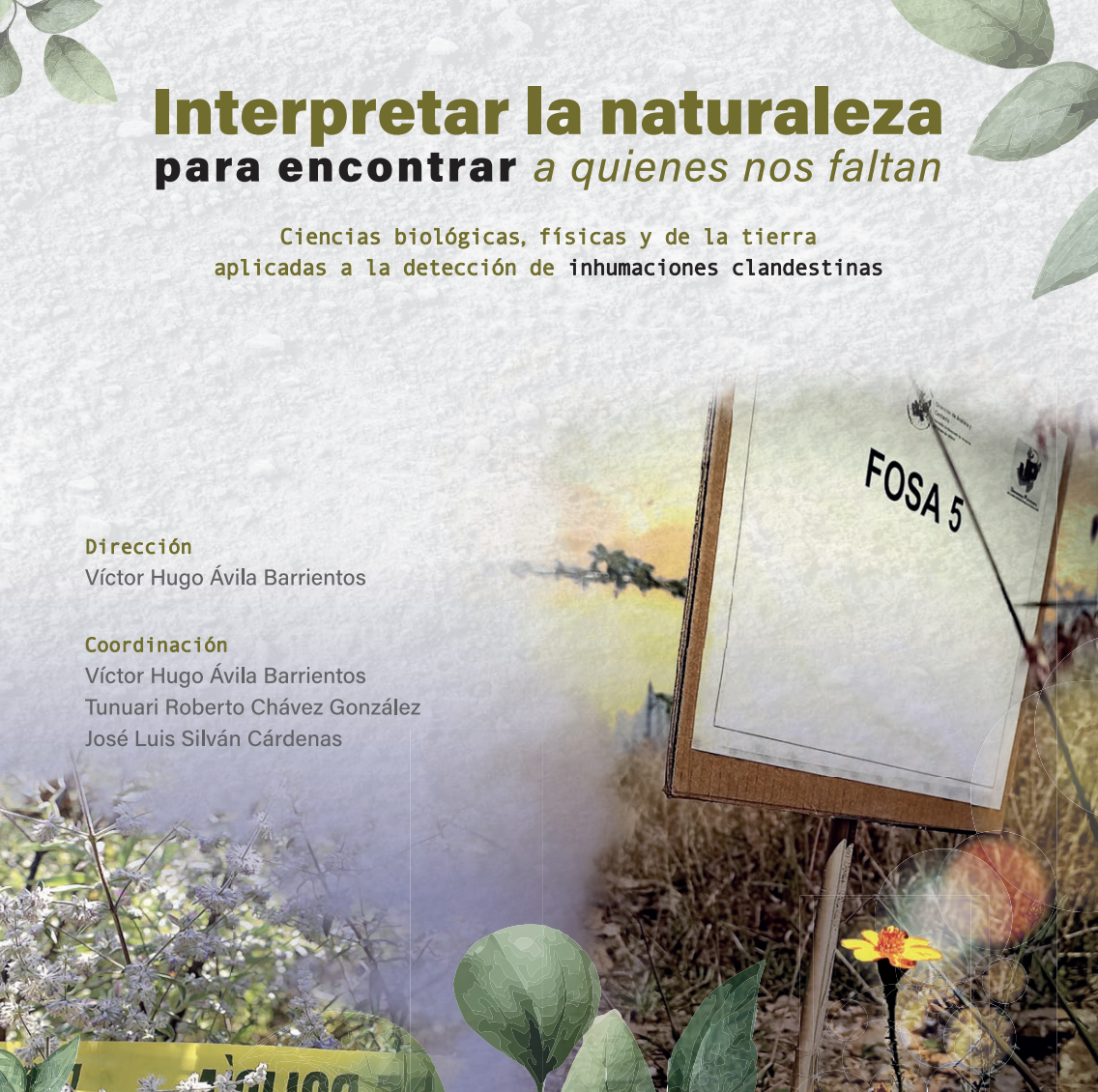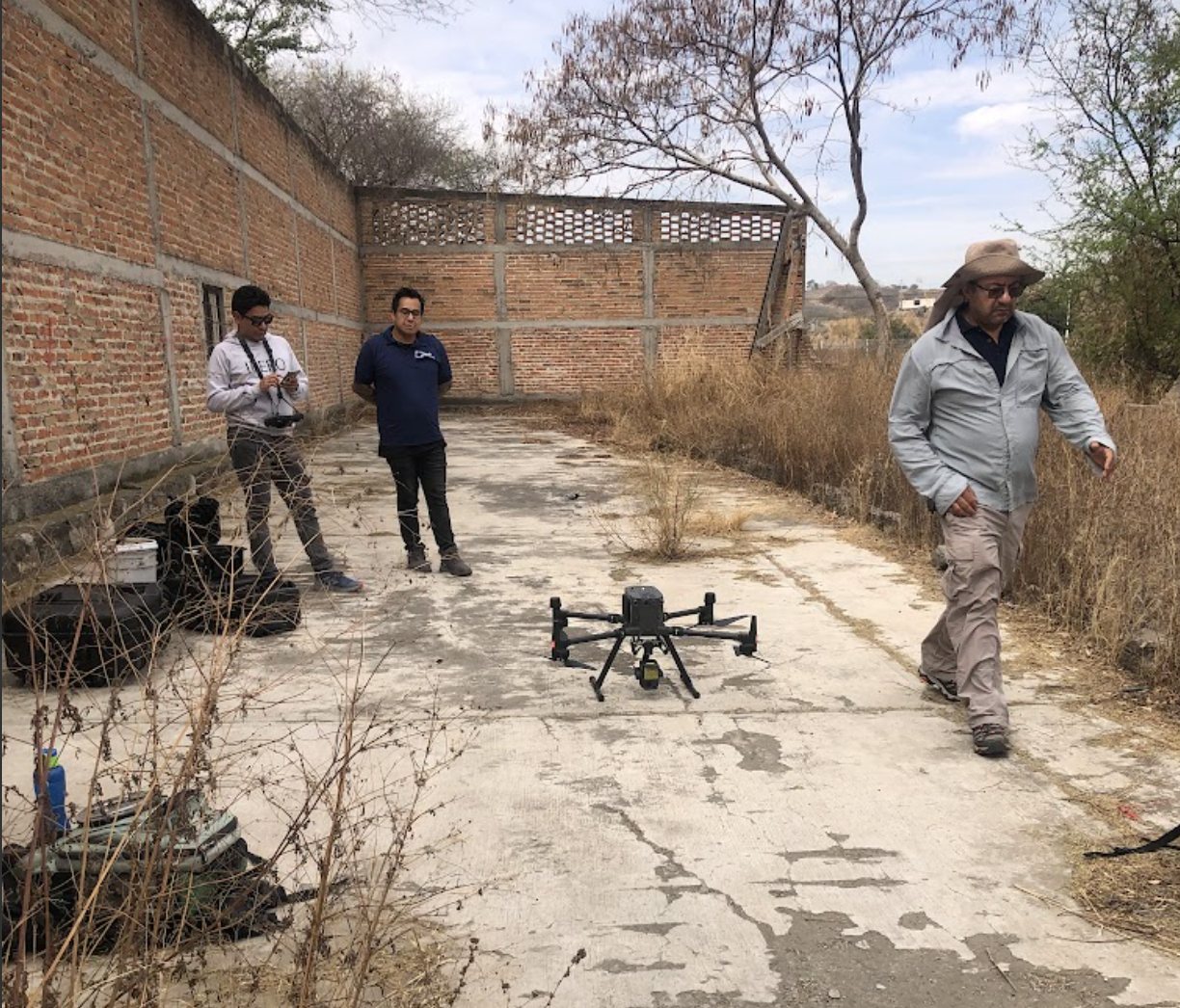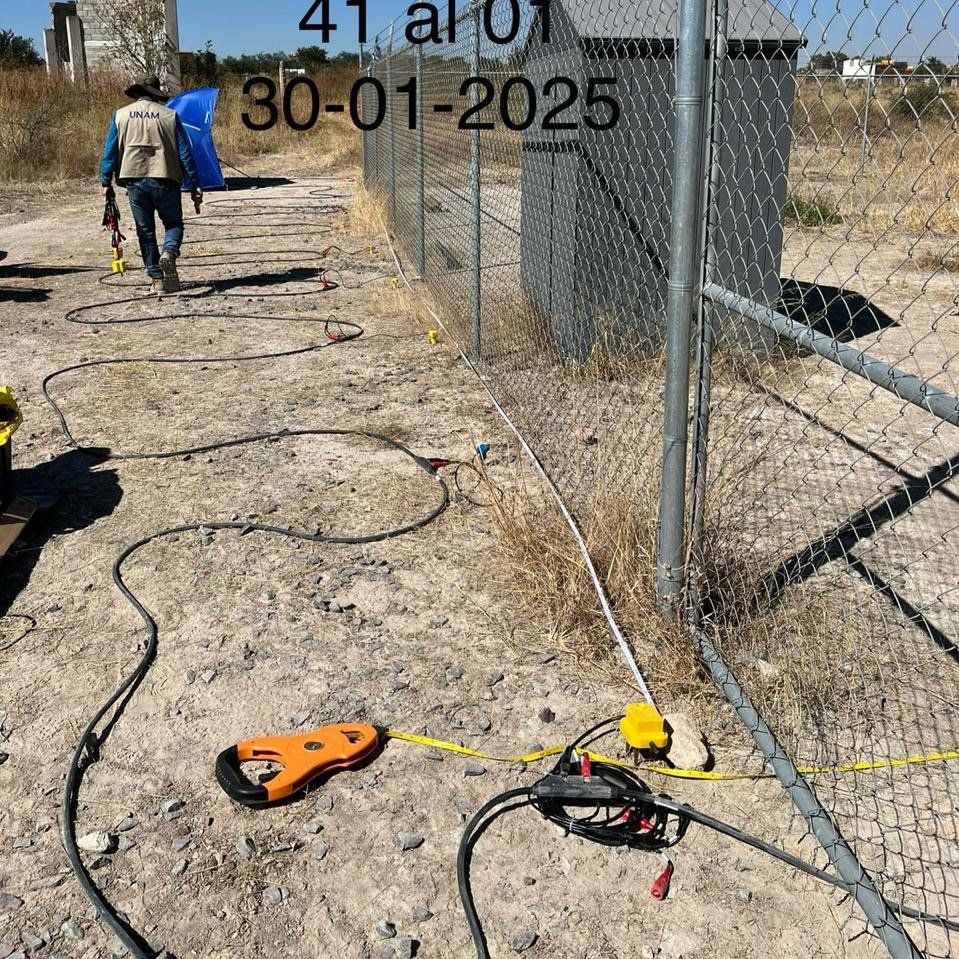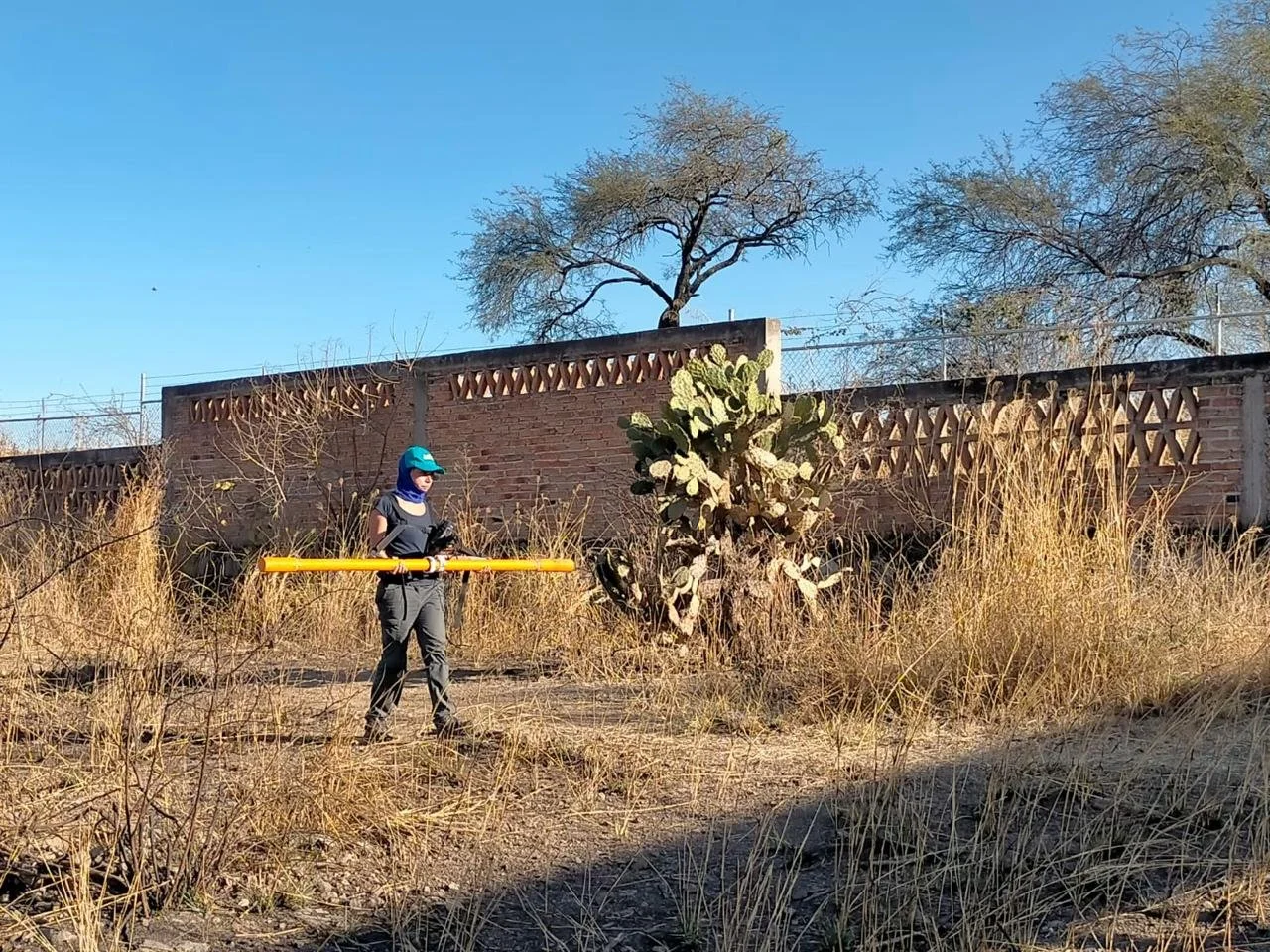Interpretating nature by sight and satellite
The pilot project FOUND leverages science and technology to support searching mothers to locate the clandestine graves of their disappeared loved ones, combining their extensive grassroots knowledge with cutting-edge technological tools to bring closure to families in desperate need of peace.
Early signs from our experiments are incredibly promising. As of July 2025, we have located 27 disappeared persons, bringing answers and a measure of closure to 27 searching families. This feat was achieved using electrical resistivity techniques, where an electric current is injected into the ground and the resistance within the soil is measured. This helps to determine where there are differences in the earth, which could point to a body within.
Image credit: Guerreros Buscadores de Jalisco
There’s a long way to go, however. With over 120,000 people reported as disappeared in Mexico, we need to continue to experiment with multiple frontier technologies, both isolated and in combination, to ascertain where they can have the most potential success.
In this blog, we share details on some of the technologies used, the traditional methods they augment and experiment results so far.
Searching for nature’s clues
Madres buscadoras translates as “searching mothers" in English. They are Mexican women who search for their missing loved ones, often in groups. Some say that madres buscadoras have existed since 1977, when Rosario Ibarra de Piedra established the Comité Eureka de Desaparecidos (Eureka Committee on the Missing).
Over decades, these searching mothers, sisters and daughters have developed critical expertise in locating clandestine graves. They have learned to look for natural indicators such as depressions, new bulges, holes, insects, soil mixtures, or unusual flowers that could indicate buried bodies. They then insert T-shaped rods to detect the odour of decomposition.
Last year the FOUND team published a book in collaboration with madres buscadoras to act as a guide to apply biological, physical, and earth sciences in detecting clandestine graves. The book is called Interpreting Nature to Locate Those We Are Missing (Interpretar la Naturaleza para Encontrar a Quienes nos Faltan), and is currently being translated into English.
“It’s the sort of rod with which houses are built... that is sold at the hardware store. It’s t-shaped, so that we can hold it and penetrate the floor, but it’s a normal iron rod.
When a body is present, it generally goes straight through. There’s no resistance. That is, it doesn’t get stuck in anything at all. When they place the body [in the ground], they sometimes put lime, cement, or stones on it. In which case, yes, there is resistance.
We have managed to identify when a body is fresh or when it is already in a skeletal form, because the ground gives off a different odor, which clings to the rod. ”
Across the extensive knowledge held by the buscadoras, one thing is clear: only with extreme attention to detail is locating clandestine graves possible, regardless of the tools, instruments or technologies used. It’s common to discover graves in the same places previous groups have searched. On one occasion, bodies were found right where other buscadoras had sat down to rest a few weeks beforehand.
Every insect holds a unique clue, from beetles and worms to larvae and queen ants. But the most significant signal from nature is the presence of plants and grass. Images of small yellow flowers have become synonymous with the collective search for clandestine graves. Where most plants are wilting in the heat, searchers look for thriving plants with beautiful, vibrant colour. This additional growth indicates increased humidity in the soil beneath, which is generated by the decomposition of bodies.
The deeper scientific explanation is that the buried bodies release nutrients that generate anomalies in the chlorophyll in plant leaves. This causes the plants to take on more vivid colours and flower atypically, due to nitrogen and phosphorous enrichment.
“Life generates more life... At the end of the day, our disappeared are not completely dead, because life grows from where they are buried.”
Technologies to support, not replace
The additional chlorophyll in plant leaves is not only visible to the naked eye. Such anomalies are visible to hyperspectral cameras fitted onto drones, making their discovery quicker and more efficient.
This is just one example where technology can amplify this essential knowledge from the madres buscadoras. Amplify, support and augment, not replace. This integrated approach respects the essential role they play, holding the deeply personal and collective memory of their land.
One particular challenge for buscadoras is the differences between environments. Soil behaviour, rate of decomposition and insect habits all change across arid and humid areas. In mountainous areas for example, where the soil is compact, it’s difficult to physically sink traditional rods into the ground.
By testing a range of different technologies, we can identify which work best in different environments. Our recent experiments tested three technologies: LiDAR, electromagnetic conductivity, and seismic noise tomography, across two different sites in Guadalajara and Tonalá.
LiDAR (Light Detection and Ranging)
This drone-mounted laser scanner that zaps the ground millions of times per second, building hyper-detailed, 3D maps of the landscape. At our Guadalajara test site, LiDAR showed promise in clearly highlighting certain graves, especially those with bodies, lime, or recently disturbed soil. On the other hand, graves filled with cement or stones were challenging to detect due to minimal surface disturbances. Where tall grass was present, the LiDAR's effectiveness was limited because the laser pulses could not penetrate down to the soil, emphasising the need to pair it with additional methods in areas of dense vegetation.
Seismic Noise Tomography
This is like an ultrasound for the Earth, listening for natural vibrations in the ground to map out disturbances beneath the surface. Multiple geophones are arranged in a grid, and together, they record those vibrations. Comparing the time it takes each tiny tremor to travel between sensors presents a data map of “soft spots” underground. At the Cajititlán experimental site, this method was particularly effective, clearly identifying several graves. However, at Tonalá, the presence of substantial human activity nearby (like foot traffic and vehicles) made it hard to be precise. This result highlighted the importance of selecting quiet sites or taking repeated measurements to overcome these limitations.
Electromagnetic Conductivity
This uses a long, handheld coil which emits and measures gentle radio waves. It measures how well the soil conducts electricity, and disturbed or buried ground shows up differently than undisturbed earth. During testing at the Cajititlán site, we noticed clear anomalies around known graves, suggesting the presence of burials. However, results varied at Tonalá, due to interference from nearby metallic fencing and local environmental conditions. Minimising interferences and combining multiple antenna types could enhance the clarity of this method.
Combining strengths and honouring local expertise
As we continue to experiment, learn out loud, and refine our techniques, we remain committed to a vision where technology supports, rather than replaces, the human element at the heart of searching for the disappeared.
Next, we will be exploring new test sites to expand our knowledge across new environments. Please do follow along on our journey.
If you’d like to dig in further…
🚀 Explore this pilot’s profile page
📆 Read about their recent panel conversation in Oxford: Technological Responses to Disappearance.

